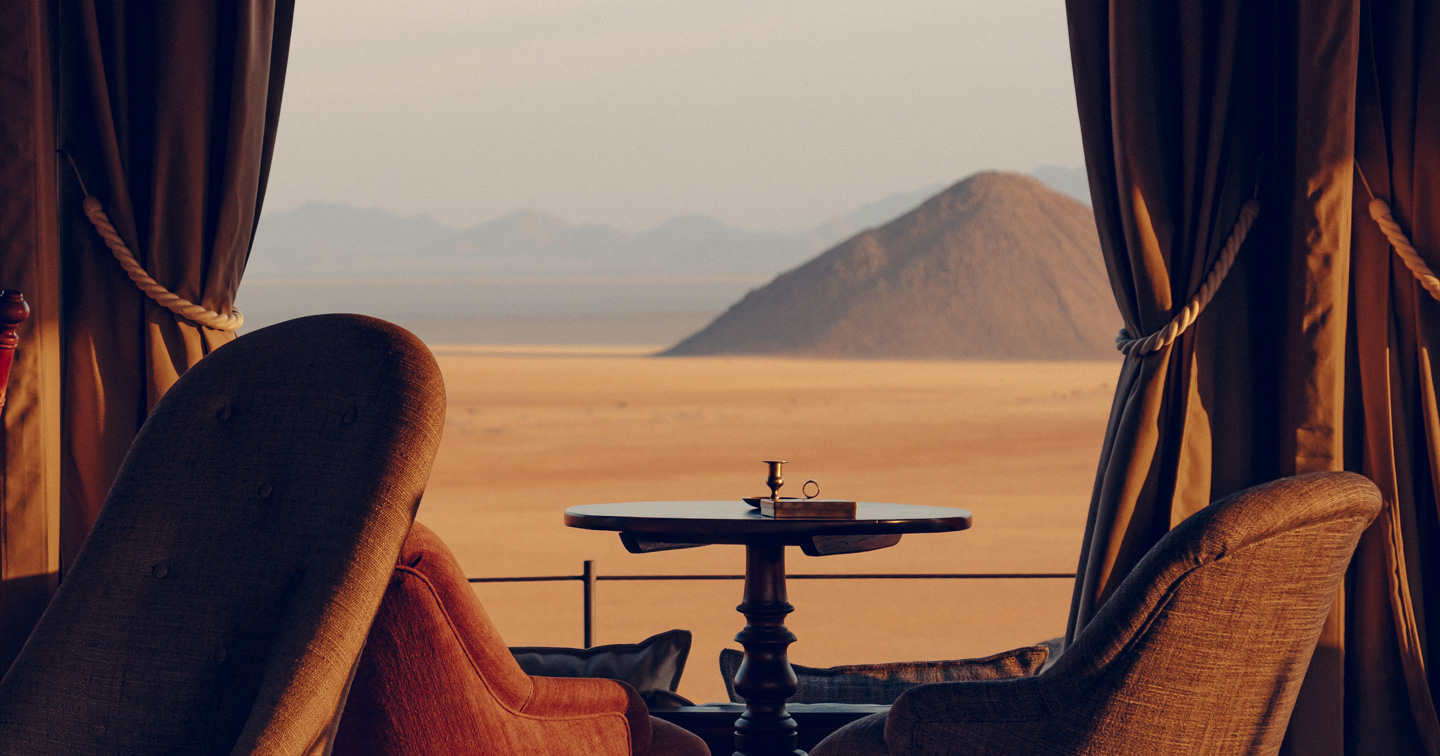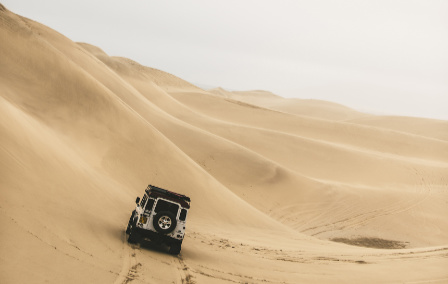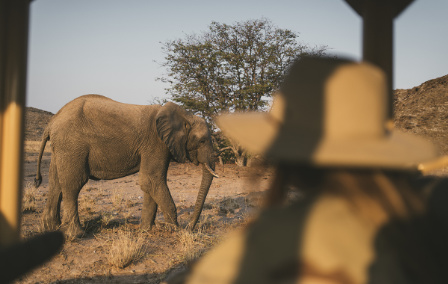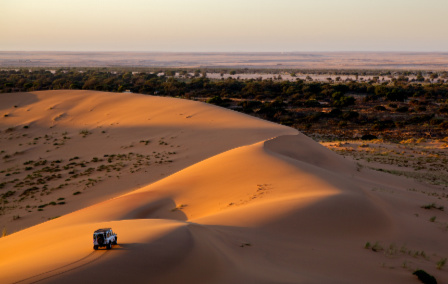Published 25th Aug. 2023
Reading time
Namibia’s wide open roads, stunning scenery and astonishing wildlife encounters make this southwest African country one of the best places in the world for a self-drive holiday. Having a car gives you the freedom to visit the places you choose at your own pace. Whether you opt for the staggering dunes of Sossusvlei, the haunting beauty of the Skeleton Coast or one of the country’s wildlife-filled national parks, there are a few things to consider when planning a self-drive safari in Namibia; here are our top ten tips to help with your planning.
1
Most of the roads in Namibia can be navigated in a 2x4. However, a 4x4 gives a more comfortable ride on unsealed roads – not only does it give you a higher ground clearance, but it also handles the gravel roads better. Consider opting for a four-wheel drive if you’re after the most comfortable self-drive safari in Namibia.
For most self-drive trips to Namibia, there will be no need to obtain any official paperwork beforehand. However, you do of course need a driving license, so don’t forget to add this to your packing list. If it’s in English and you’re staying in Namibia for less than 90 days, you won’t need an international driving license. If it’s in another language, you will need to get an international one.
2
Slow and steady wins the race during self-drive holidays in Namibia. Driving at speed along gravel roads can cause stones and small rocks to be flung up into the air, so be sure to kill your speed when approaching other vehicles, to avoid damage to their vehicle (as well as your own) and prevent harm to any pedestrians. It’s also best practice to check on anyone who has stopped on the side of the road, as they may be in need of assistance (although be sure to check for nearby wildlife before getting out of your car to help them!).
3
While roads are graded regularly, there is very rarely a wide shoulder. Sides of the roads can be very sandy, or rocky, making it easy to get stuck or to damage your tyres.
4
The roads in Namibia are not very tyre friendly, meaning unfortunately punctures are not uncommon. It’s wise to check your tyres when you stop and know how to change them in case you have cause to. Carrying a second spare wheel is also not a bad idea.
5
Despite its harsh climate, Namibia is home to an abundance of both free-ranging wildlife and domestic animals, such as sheep, donkeys and goats. Always remain alert during your self-drive safari in Namibia and slow right down if there are any animals in the road; some animals may be oblivious to oncoming traffic and take their time to cross the road (especially donkeys and goats).
6
Roads in Namibia are often poorly lit, while those outside of cities and towns are rarely lit at all. To add to these already not ideal driving conditions, many animals are active at night – particularly during the balmy summer months – and are difficult to spot in the dark. For example, kudu have a habit of jumping into headlights. So for these reasons, we strongly advise to not drive at night and to plan a trip of daytime drives.
7
Most car hire companies in Namibia will include a GPS as standard, but be sure to check that the rental agreement you’re signing does contain one. Mobile phone reception can be patchy in more remote areas, so a GPS will act as a much more reliable tool for getting you from A to B.
8
Distances may seem doable when planning your trip – but you need to ensure you allow ample time for getting between places. If Google Maps estimates that a journey will take five hours, we suggest factoring in seven. Road conditions can be unpredictable; some parts may be smooth and easy going, allowing for decent speeds, while other sections could be badly corrugated and you’ll have to halve your speed. You’ll also want to leave time for photo stops and loo and lunch breaks along the way.
9
One of the beautiful things about Namibia is the lack of human habitation; the country is a patchwork of wide open spaces, far-reaching landscapes and uninterrupted natural beauty. Towns and villages are few and far between. Hence, you will often find yourself in the middle of nowhere without any access to food or drink. To combat this, make sure to pack plenty of water and food to snack on while you’re on the road.
10
As well as ensuring you keep yourselves fuelled with snacks, it’s also vital to make sure that the petrol tank of your car is always topped up. As a general rule, don’t let your tank drop below half full and fill up whenever you have the chance. Running out of fuel can really scupper your plans during self-drive safaris in Namibia; it could result in you having to drive to your next destination in the dark, which, as we mentioned, is something you should avoid.
Written by Luisa Watts

Our trips to Namibia are personalised just for you, from kickstarting a honeymoon with a romantic bush dinner to securing a manual land cruiser for your intrepid self-drive safari. We can arrange your dream accommodation, too, whether your style is more suited to a desert camp tucked in red sand dunes or an Arabic-style fort in a private reserve. What’s more, let us know your interests, and we’ll recommend cultural, historical and sporting experiences that are right up your street.
ENQUIRE NOWPractical advice and inspiration for your next trip

Narrowing down the best national parks in Namibia is no easy feat. But we’re up to the challenge. For excellent wildlife and bird-watching opportunities, head to Etosha National Park and Bwabwata National Park. If you're looking for surreal landscapes, visit Namib-Naukluft and Skeleton Coast national parks, while Ai-Ais Richtersveld Transfrontier National Park is your go-to for rugged hiking trails.
13th February 2025 - Namibia Travel Inspiration

When it comes to sustainable travel, we’ve taken inspiration from Japanese art. Their concept of kintsugi refers to repairing broken pottery with gold lacquer to create something more beautiful than the original. Ever since the pandemic tore the tourism industry to the ground, we’ve wanted to be the gold lacquer piecing travel back to be better than before. So, it’s no surprise that we’ve been shouting about sustainable concepts like undertourism for a whole range of countries – and Namibia is no exception.
3rd June 2024 - Namibia Responsible Travel

Namibia’s wide open roads, stunning scenery and astonishing wildlife encounters make this southwest African country one of the best places in the world for a self-drive holiday. Having a car gives you the freedom to visit the places you choose at your own pace. Whether you opt for the staggering dunes of Sossusvlei, the haunting beauty of the Skeleton Coast or one of the country’s wildlife-filled national parks, there are a few things to consider when planning a self-drive safari in Namibia; here are our top ten tips to help with your planning.
25th August 2023 - Namibia Travel Tips

Our team of destination experts will get to know you and your unique requirements for your holiday

We work with you to build an ultra-personalised holiday itinerary with your choice of accommodation, experiences and activities

All of our holidays include little extras designed to make a big difference to your trip, from fast-tracking you through airport check-in and security to our network of local Concierges